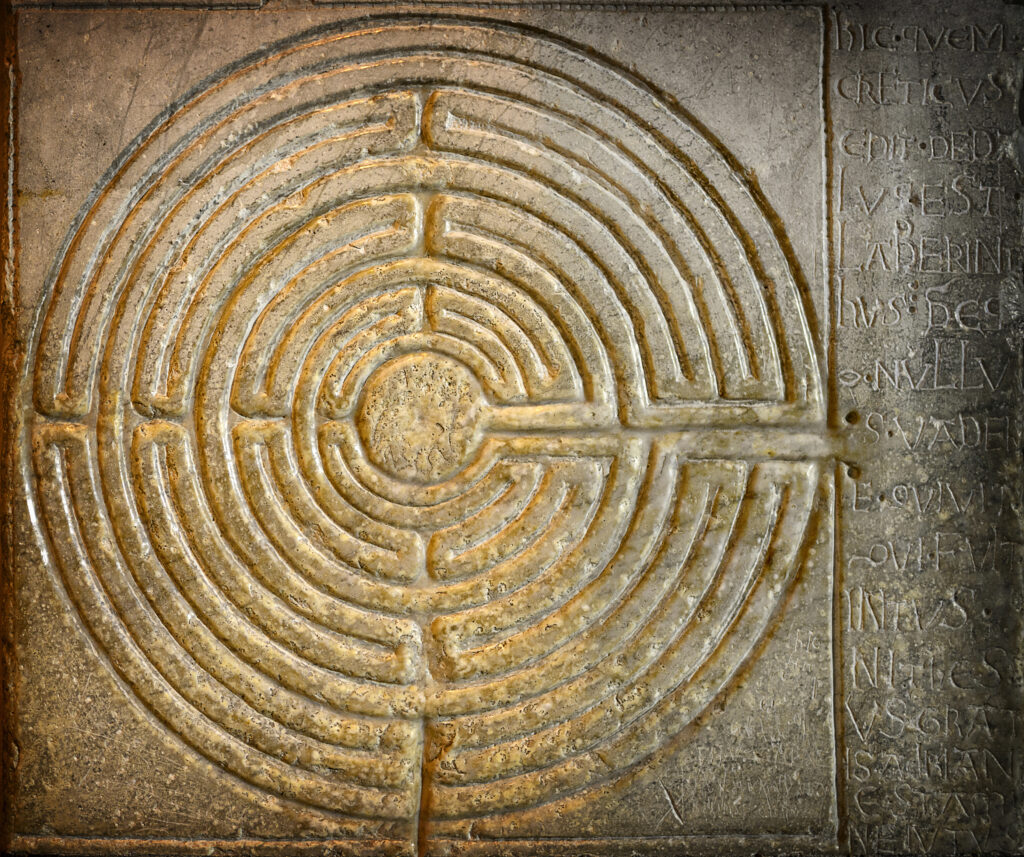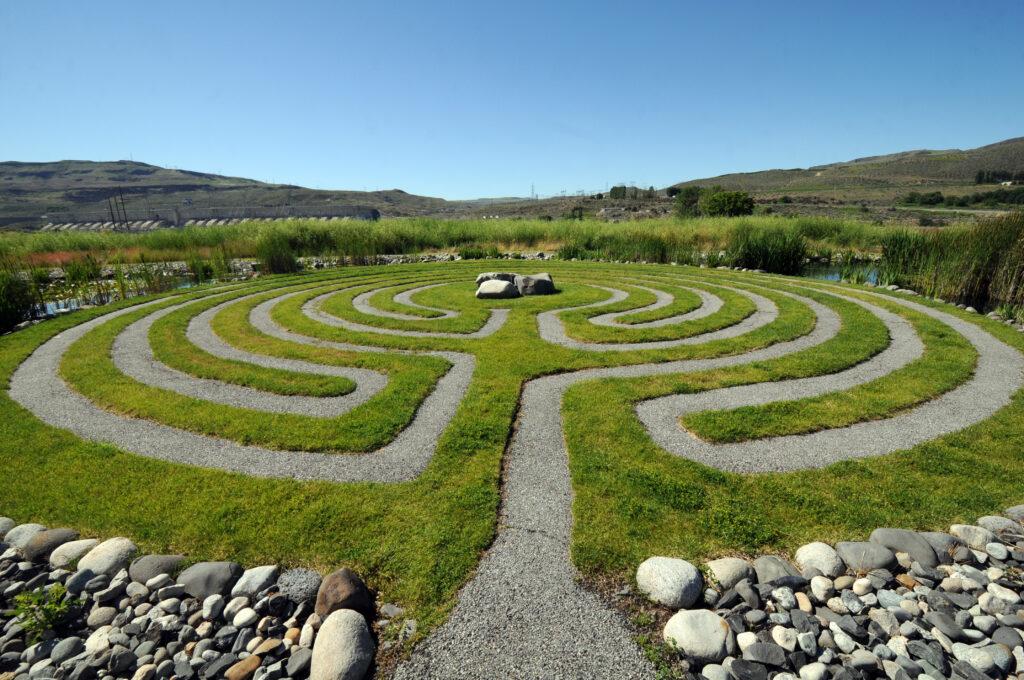How are Labyrinths Used in Recreational Settings
 Labyrinths and mazes have been part of recreational life for millennia. They were used in conjunction with sophisticated games in ancient Greece on through the medieval period in Europe. Scant records exist about dances and games played in labyrinths in medieval churches and more recently in labyrinths, especially those still found in England and across Scandinavia. When formal gardens and parks arose during the Renaissance in Europe, they at times included labyrinths and mazes. Today, labyrinths are undergoing a modern revival in response to the contemporary needs of our times. As cultural enhancements to modern parks, labyrinths are flexible in their ability to meet both the contemplative and active recreational needs of park users, making them unique features that almost everyone can use and benefit from.
Labyrinths and mazes have been part of recreational life for millennia. They were used in conjunction with sophisticated games in ancient Greece on through the medieval period in Europe. Scant records exist about dances and games played in labyrinths in medieval churches and more recently in labyrinths, especially those still found in England and across Scandinavia. When formal gardens and parks arose during the Renaissance in Europe, they at times included labyrinths and mazes. Today, labyrinths are undergoing a modern revival in response to the contemporary needs of our times. As cultural enhancements to modern parks, labyrinths are flexible in their ability to meet both the contemplative and active recreational needs of park users, making them unique features that almost everyone can use and benefit from.
As the centerpiece or destination point of serene settings in public parks, labyrinths are quiet oases where people can pause, step out of the frenetic pace of life, and take time to rejuvenate. While labyrinths may be new developments in modern parks, the need for contemplative spaces in community parks is well-established. People have always visited parks for rest, renewal, and introspection, but restorative environments are needed today more than ever before. Labyrinths are both contemplative tools and restorative environments that help people respond to the complexities of modern life. As design elements, labyrinths are beautiful and intricate patterns that are aesthetically pleasing. When incorporated into public spaces they revitalize or add beauty to the surrounding area.
As a leisure activity, labyrinths are enjoyed by children and adults alike as a simple, but fun way to follow a winding path. They can also be used by organizations and groups for team-building, creativity, and problem-solving. In their most powerful applications labyrinths are attractive features in public settings that impact large scale healing and change, add aesthetic value to the surrounding area, empower the community’s intangible assets, build upon its cultural capital, stimulate economic development, attract new visitors to the area, and nourish the individuals and organizations in the communities that use them.
Why Community Labyrinths
While many churches have either temporary canvas labyrinths or more permanent installations, it is important to have labyrinths in public, secular settings. In a neutral space such as a public park, diverse groups are more likely to come together and share this powerful experience, providing opportunities for community engagement and healing. Therefore, the labyrinth and surrounding environment should not contain symbols or attempt an interpretation to insure that no one feels excluded. Individuals are then able to bring their own interpretation and meaning to the labyrinth experience. However, community labyrinths can be an opportunity to address community issues.
Possibilities in Economic Development
An investment in labyrinths could potentially impact economic development. Features such as the labyrinth fit right into retaining and attracting creative talent, along with enlivening the area in which they are offered and providing an unusual and interesting centerpiece for community events. Creative workers and leaders from business and the non-profit sectors must work together to build the caring and learning communities needed today. When the labyrinth is utilized intentionally as a tool for harnessing the creative power of individuals, organizations, and institutions, who knows what the ripple effect can be for the community at large. Labyrinths can be part of a community engagement initiative to bring leaders together from many different sectors (such as business, non-profits, educational institutions, etc.). Widespread adoption of labyrinths as tools for personal and organizational development could ultimately impact the creative output of an entire community. As tools for creativity, team-building, and problem-solving, labyrinths can be used to cultivate the creative and cultural capital of a community, enhancing innovation and promoting a strong economy.
Other Considerations
The Labyrinth Setting
Labyrinths are contemplative tools for reflection and introspection that need to be in a serene, natural environment to be effective. The walker needs a feeling of peace and tranquility, as well as a sense of safety and refuge. There should be few distractions so that the surroundings do not detract from the labyrinth experience. Since the walker is reflecting and not completely aware of their surroundings, they should not be too isolated from others or out of view. They should be away from heavy traffic and active/noisy sports, but should not be isolated since safety is an issue.
Other important elements include:
- Benches or other seating to allow for reflection and journaling
- Soft lighting for evening community walks
- Signage directing people to the site and instructing people how to use it
- Landscaping to enhance the experience
- Covered space with seating nearby for groups to discuss the intent of the walk, walk, then discuss
- Shade
If the space includes a sculpture garden, the art should not interfere with the contemplative experience. The walker needs to relate to the art and feel nurtured and supported. The benches could have a distinctive design associated with all the labyrinths and other contemplative spaces. The TKF Foundation, which funded labyrinths and serene environments in Maryland, found distinctive benches with waterproof journals to be an effective strategy. They report that “The journal has been an amazing addition to the spaces. It provides visitors the opportunity to connect with earlier visitors and to share their thoughts. It has also been a cathartic tool for those who simply need to unload their burdens by writing them down. Because people tend to focus on things that are central to their lives, the journal entries can be powerful and moving writings.”
Indoor or Covered Labyrinth
An indoor labyrinth or one covered by a pavilion allows people to walk in cold or rainy weather and provides safety in the evening, more accessibility to those handicapped, and potentially rental income. An indoor facility can be designated by the community and rented for use by groups for workshops, retreats, or weddings.
Robert Ferré discusses some of the considerations in his booklet, Planning for Labyrinths: Design Considerations and Guidelines for Architects and Building Committees. [While this booklet focuses on hospital and church installations, much of it equally applies to parks.
Types of Installations
Labyrinth installations can be simple or elaborate, inexpensive or $100,000 installations. Inexpensive installations often require more maintenance, so planning is critical. Options include:
- Grass with brick or stepping stones (the path or the lines can be grass)
- Mowed pattern in grass (turf labyrinths) with the paths gradually receding
- Paint on concrete
- Incised concrete
- Pavers or stone
Labyrinth Builders
Some of the simpler installations can be done with volunteers advising park staff or contractors. But if the park selects one of the more involved, expensive installations using concrete, pavers, or stone, we recommend using an experienced labyrinth builder.
Funding and Community Partnerships
Community labyrinths can be funded through partnerships with organizations seeking ways to make the public more aware of community issues and encourage community participation in the creation of the labyrinth. A labyrinth could be a memorial to peace, veterans, tolerance, cancer survivors, or victims of violence where individuals “buy a brick.” The Columbine Peace Labyrinth in Littleton, Colorado, is an example of a memorial labyrinth.
Labyrinth installations can also be an art project. The National Endowment for the Arts (NEA) has funded labyrinths as design arts projects where artists, landscape architects, and the community collaborate to create an environment.
Labyrinths and Tourism
Labyrinths can be an exciting part of a trail of contemplative spaces linking public gardens and other sites and promoted by the Convention and Visitors Bureau.
Labyrinths in Parks
In the past there were only a few labyrinths in public parks. Some were maintained by other organizations. The trend has been increasing as labyrinths go mainstream.
We have identified some of the labyrinths available in public parks in the United States below.
To search for more, please visit the World Wide Labyrinth Locator.
- Armenian Heritage Park, Boston, Massachusetts
- Riverwalk Park, Naperville, Illinois
- Audubon Park, New Orleans, Louisiana
- City Park, Baton Rouge Louisiana
- Trinity Square Park, Toronto
- Urbana Park District, Illinois
- Central Park, Burlington, Ontario
- Historic New Harmony State Park, Indiana
- Granville Citizen’s Park, Massachusetts
- Hamilton Park, fitness park/trail, Greencastle, Indiana
- Garfield Park, Chicago, Illinois
- Georgetown Waterfront Park, Annapolis, Maryland, a National Park on the Potomac
We hope that more communities will consider including labyrinths in public parks as part of their public recreational strategies.






